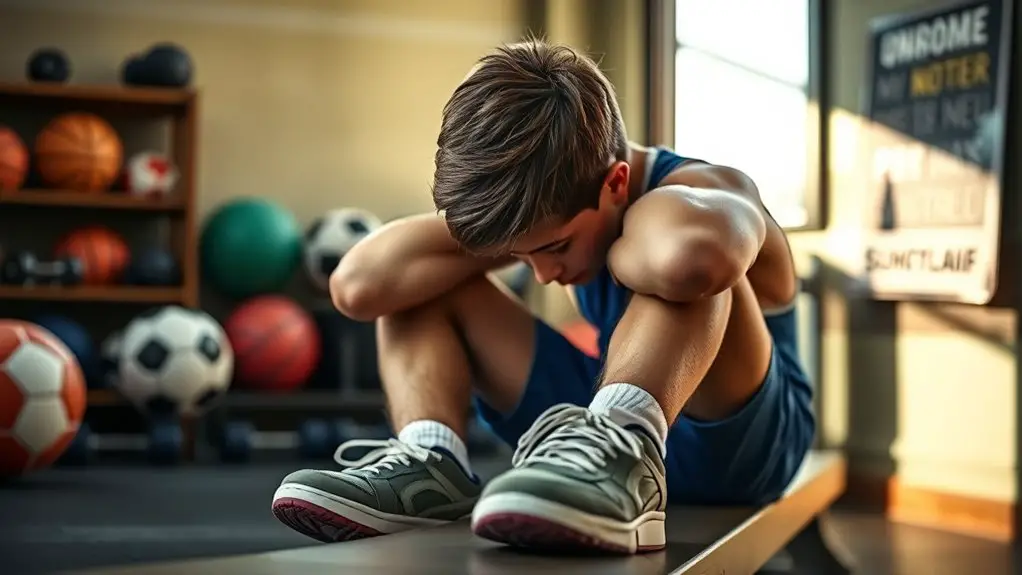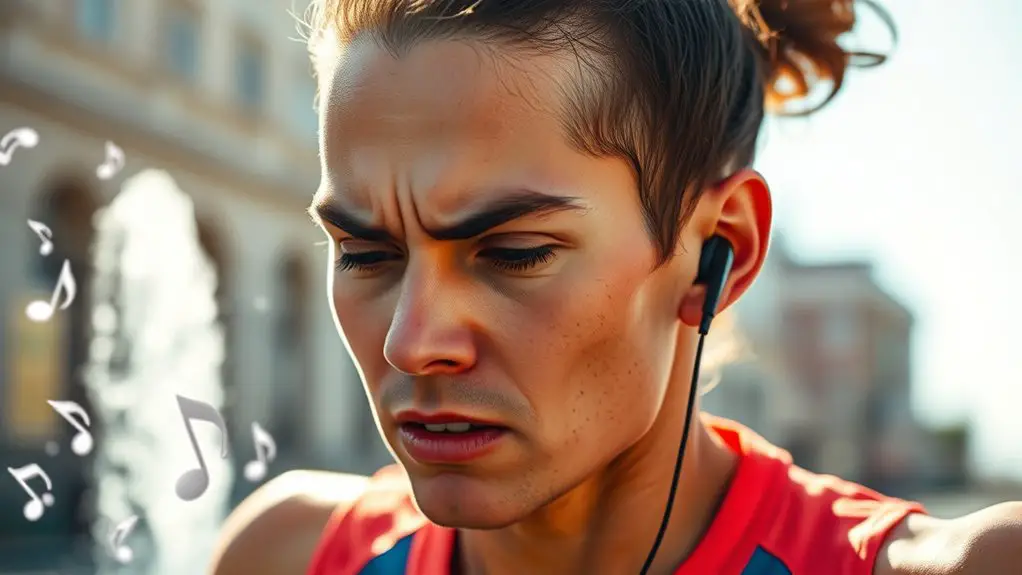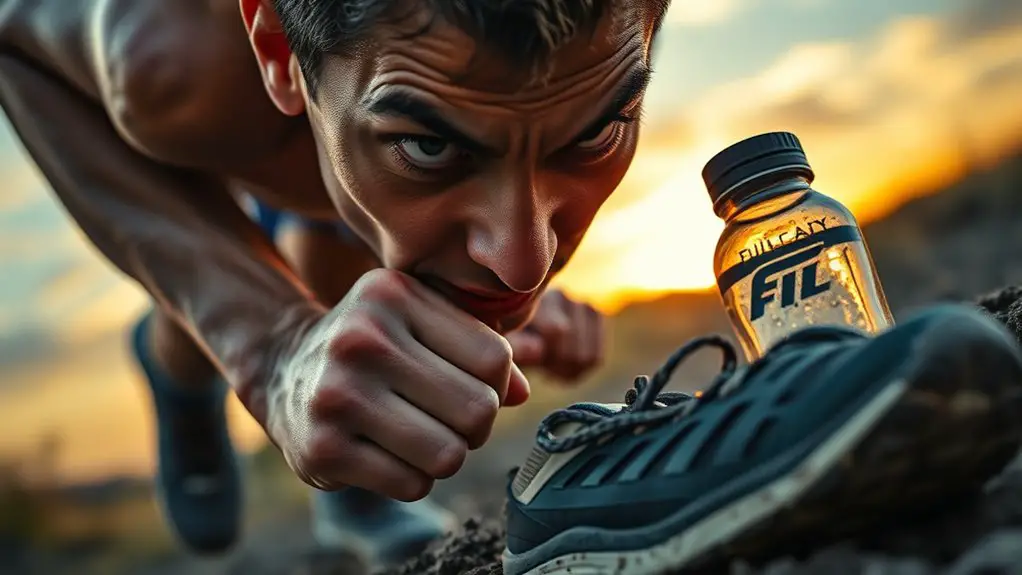To train your peripheral vision for better athletic performance, start with focused vision drills, like color recognition and wall stares. Incorporate dynamic movement practices, such as agility drills while keeping your head up. Use vision training tools, including eye tracking software and reaction balls, to enhance reflexes. Don't forget to practice multitasking drills and team activities. These techniques can help you become more aware and responsive. Keep exploring more ways to boost your peripheral skills for success on the field.
Understanding Peripheral Vision and Its Importance in Sports
Although you might focus intently on what's directly in front of you during a game, understanding peripheral vision is essential for enhancing your performance in sports. This skill allows you to see movements and players outside your direct line of sight, which can be a game-changer. Imagine dribbling down the court, yet being aware of an opponent sneaking up from the side—this awareness can prevent turnovers and create scoring opportunities.
The sports significance of peripheral vision can't be overstated. It helps you anticipate plays, avoid collisions, and react swiftly to changing situations. By honing this ability, you're not just reacting to what's happening in front of you; you're engaging with the entire field or court. This broader awareness gives you the freedom to make better decisions, enhancing your overall gameplay and contribution to your team. Embracing peripheral vision can transform how you experience and excel in sports.
Simple Exercises to Enhance Peripheral Awareness
To enhance your peripheral awareness, you can try a couple of simple exercises that focus on both vision and movement. Incorporating focused vision drills will sharpen your ability to notice what's happening around you, while dynamic movement practices can improve your overall responsiveness. Let's explore these effective techniques to boost your peripheral vision skills.
Focused Vision Drills
Enhancing your peripheral awareness starts with simple focused vision drills that train your eyes and brain to pick up on cues outside your direct line of sight. These exercises can free you from limitations and heighten your athletic performance. Here are four effective drills to get you started:
- Wall Stare: Focus on a spot on the wall while noticing movements in your peripheral vision.
- Color Recognition: Identify colors of objects around you without turning your head.
- Ball Toss: Toss a ball with a partner while maintaining focus on a target.
- Visual Distraction Techniques: Use distractions to improve your eye coordination drills, enhancing your ability to stay focused amidst chaos.
With consistent practice, you'll release your potential and enjoy the freedom of enhanced awareness.
Dynamic Movement Practices
Dynamic movement practices are an excellent way to boost your peripheral awareness while also improving your overall coordination and agility. Incorporating dynamic stretching into your routine helps activate your muscles and enhances your body's range of motion. Try exercises like walking lunges or high knees, which keep you moving and engaged.
Agility drills, such as ladder drills or cone sprints, challenge your body to react quickly while maintaining awareness of your surroundings. As you weave through obstacles, focus on your peripheral vision by keeping your head up and eyes forward. By blending these movements, you'll not only sharpen your athletic skills but also foster a sense of freedom in your performance. Embrace the flow, and let your body guide you!
Vision Training Tools and Equipment
Vision training tools and equipment are essential for effectively sharpening your peripheral awareness. By utilizing the right gear, you can break free from limitations and enhance your athletic performance. Here are four must-have items to bear in mind:
- Vision enhancement devices: These tools help you train your eyes to quickly adapt to different visual stimuli, boosting your overall vision capabilities.
- Eye tracking software: This tech tracks your eye movements, allowing you to identify and improve your focus and peripheral engagement.
- Reaction balls: These unpredictable bouncing tools train your reflexes and peripheral reaction time, vital for on-the-field performance.
- Visual training glasses: These specialized glasses can help strengthen your eye muscles and improve your depth perception.
Investing in these tools will empower you to access your potential, paving the way for greater freedom in your athletic journey.
Incorporating Peripheral Vision Drills Into Your Practice
To effectively train your peripheral vision, it's important to incorporate specific drills into your practice routine. You can start with targeted eye movement exercises, then progress to multi-tasking reaction drills that challenge your focus. Finally, integrating vision-focused team activities can further enhance your skills in a dynamic environment.
Targeted Eye Movement Exercises
Incorporating targeted eye movement exercises into your training routine can greatly enhance your peripheral vision. By improving eye tracking and gaze stabilization, you'll tap into your athletic potential and feel more in control during competition. Here are four exercises to help you access that freedom:
- Focus Shifts: Alternate your gaze between near and far objects to enhance depth perception.
- Peripheral Glances: While focusing on a central point, identify objects in your periphery, strengthening your awareness.
- Tracking Objects: Follow a moving target with your eyes while keeping your head still to improve fluidity.
- Circle Vision: Move your eyes in a circular motion to expand your visual field.
Embrace these exercises, and watch your game change!
Multi-Tasking Reaction Drills
Building on the targeted eye movement exercises you've been practicing, multi-tasking reaction drills can take your training to the next level. These drills not only sharpen your peripheral vision but also enhance your overall reaction time. Start by combining simple tasks; for instance, dribble a ball while responding to verbal cues or visual signals from a partner. This challenges your brain to process multiple stimuli simultaneously, improving your ability to multitask during competition. You might also incorporate agility ladders or cones to create dynamic environments where you must react swiftly while maintaining focus. By regularly practicing these multi-tasking techniques, you'll find yourself more aware and responsive, giving you the freedom to perform at your best when it counts.
Vision-Focused Team Activities
While practicing peripheral vision drills individually is beneficial, integrating these exercises into team activities can amplify their effectiveness. By fostering team communication and strategic positioning, you'll reveal a new level of performance.
Here are four engaging vision-focused team activities:
- Blindfolded Passing: One player is blindfolded while others call out directions, enhancing trust and awareness.
- Obstacle Course Relay: Navigate a course while maintaining eye contact with teammates, honing both focus and peripheral awareness.
- Dynamic Formation Changes: Shift formations while keeping an eye on all teammates, promoting strategic positioning.
- Color Callouts: Coaches call out colors or shapes while players must react, sharpening visual acuity and communication.
These activities can help you and your team embrace freedom on the field, enhancing your connection and performance.
The Role of Eye Movement and Focus in Peripheral Vision
Understanding how eye movement and focus contribute to peripheral vision is essential for enhancing your visual awareness. Your eyes constantly shift, tracking objects and adjusting focus, which helps you maintain awareness of your surroundings. This eye tracking is vital for athletes who need to spot teammates, opponents, or obstacles quickly.
By consciously directing visual attention toward a central target while remaining aware of what's happening in your periphery, you can improve your reaction time and decision-making. Practicing this dual focus allows your brain to process more information simultaneously, expanding your visual field.
Engage in drills that encourage you to maintain focus on a primary target while monitoring movements around you. This balance of focus and awareness can liberate your performance, letting you react instinctively without losing sight of the bigger picture. Embrace the freedom that enhanced peripheral vision brings to your athletic endeavors!
How to Measure and Track Your Progress
To truly enhance your peripheral vision, it's important to measure and track your progress effectively. By incorporating progress monitoring into your training, you can see how far you've come and what areas need improvement. Here are some assessment techniques you can use:
- Visual Field Tests: Regularly assess your ability to detect movement or objects in your peripheral vision.
- Reaction Time Drills: Time yourself as you respond to stimuli appearing in your peripheral field.
- Tracking Exercises: Use objects moving across your field of vision, noting how well you can keep them in sight.
- Video Analysis: Record your training sessions and analyze your peripheral awareness during gameplay.
Combining Peripheral Vision Training With Other Skills
Incorporating peripheral vision training with other skills can greatly enhance your overall performance, especially in sports and activities requiring quick decision-making. By merging visual coordination with agility drills and cognitive flexibility exercises, you'll improve not just your awareness but also your reaction times.
Here's a simple table to help visualize this approach:
| Skill | Training Method | Benefit |
|---|---|---|
| Peripheral Vision | Vision drills | Enhanced awareness |
| Agility | Ladder drills | Improved foot speed |
| Cognitive Flexibility | Reaction time games | Faster decision-making |
| Overall Performance | Combination workouts | Greater athletic success |
When you focus on combining these elements, you'll find that your ability to adapt and respond on the field or court becomes second nature. It's all about developing a holistic approach that empowers your athletic freedom!
Tips for Maintaining Focus During Games
While it's easy to get distracted during intense games, staying focused is essential for peak performance. By honing your mental resilience and enhancing your game awareness, you can elevate your play and thrive under pressure. Here are some tips to help you maintain that laser-like focus:
- Breathe Deeply: Take a few deep breaths to center yourself and clear your mind of distractions.
- Visualize Success: Picture yourself executing plays flawlessly, reinforcing positive outcomes.
- Stay Present: Focus on the current moment, letting go of past mistakes or future worries.
- Engage with Teammates: Communicate and connect with your teammates to foster a shared energy and concentration. Additionally, creating a consistent routine can enhance your mental preparation and focus during gameplay.
Real-Life Examples of Athletes Who Excel in Peripheral Vision
Many elite athletes showcase exceptional peripheral vision, which greatly enhances their performance on the field or court. Take basketball superstar LeBron James, for example. His ability to see teammates and opponents out of the corner of his eye allows him to make quick, strategic passes, elevating his game to another level. Similarly, soccer legend Lionel Messi relies on his peripheral awareness to navigate tight defenses and create scoring opportunities. These famous athletes often incorporate specific training routines to sharpen their peripheral vision. Drills like reaction ball exercises or using vision training apps can help you develop the same skill. By studying how these top performers utilize their peripheral vision, you can gain insights into your own training. Embracing these techniques will not only improve your awareness but also give you the freedom to perform at your best, just like the athletes you admire. Additionally, mental alertness and awareness enhance reaction time significantly, which is vital in maximizing the benefits of peripheral vision training.
Frequently Asked Questions
Can Peripheral Vision Training Improve Reaction Time in Athletes?
You might just find that sharpening your peripheral vision can be like opening a hidden door to faster reaction times. As you enhance your ability to see beyond the obvious, your athletic performance could soar to new heights. It's not just about what's in front of you; it's about the whole picture. By training your eyes to catch those subtle movements, you'll dance through the game with a swiftness that feels truly liberating.
How Long Should I Train Peripheral Vision Each Week?
When it comes to weekly training for peripheral vision, you don't need to overdo it. Aim for about 30 to 60 minutes spread throughout your week. You can break this down into shorter sessions, so it fits easily into your routine. Consistency is key, but it shouldn't feel like a chore. Enjoy the process, and you'll see improvements without feeling restricted. Balance your training with other activities for a well-rounded approach!
Are There Age Restrictions for Peripheral Vision Training?
You might be surprised to learn that there aren't strict age restrictions for peripheral vision training. Youth athletes can benefit from various training methods, enhancing their visual awareness and overall performance. Starting early can give them a competitive edge, but it's crucial to verify the exercises are age-appropriate. Embracing this training can set you free, allowing you to explore your potential and sharpen your skills, no matter your age. Keep pushing those limits!
Can Peripheral Vision Training Reduce Injuries in Sports?
Yes, peripheral vision training can play a role in injury prevention. By incorporating vision exercises into your routine, you enhance your awareness of your surroundings, which can help you react more quickly to unexpected movements or obstacles. This heightened awareness reduces the chances of collisions and falls, ultimately keeping you safer on the field or court. Embracing this training not only improves your performance but also grants you greater freedom to play confidently.
Is There a Specific Diet to Support Vision Training?
Imagine your eyes as windows to a world of freedom and agility. To support your vision training, consider incorporating vision supplements rich in vitamins A, C, and E, which can enhance your eye health. Pair that with eye exercises that stretch and strengthen your focus. This combination not only nurtures your vision but also releases your potential, letting you see the possibilities ahead while you soar through your athletic pursuits.




